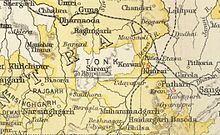|
Raghogarh State
  Raghogarh State, also known as Raghugarh and as Khichiwara, was a princely state of the Gwalior Residency,[2] under the Central India Agency of the British Raj. It was a Thikana state of about 109 km2 with 19,446 inhabitants in 1901. The Parbati River marked the western border of the state.[3] The capital was at Raghogarh in the present-day Guna district of Madhya Pradesh.[3] History
Raghogarh State was established in 1673 by Lal Singh Khichi, a Rajput of the Chauhan Khichi clan, a branch of the clan to which Prithviraj Chauhan the founder of Delhi belonged.[citation needed] The state took its name from the fort of Raghogarh, founded in 1673 by Raja Lal Singh in 1677.[citation needed] Raghogarh had its fortune wane due to Maratha attacks led by Mahadaji Shinde in around 1780. By 1818, there were disputes regarding succession in Raghogarh, which were settled through the intervention of the British authorities.[3] RulersThe ruling family were members of the Khichi Chauhan Dynasty of Rajputs.[4] The rulers used the title of Raja.[3] Hindupat Raja Lal Singhji (1673 – 97 A.D.) founded the State of Raghogarh. Raja Lal Singh usually resided in Pargana, where he happened to discover a saptdhat[what language is this?] image of Ram (Raghoji) on the top of a hill. He established this image in the fort palace of Raghogarh, which he founded in 1677–1734 (Magh Sudi 5) on an elevation in the village of Kotda. With the transfer of the capital to Raghogarh, Gugor was added to the Thikana of Chhabra, which came to be called Chhabra Gugor. Lal Singhji built mansions and temples, dug tanks and baoris (stepwells), and laid a garden. Lal Singhji was the son of Raja Garibdas. Amongst his three brothers, one got the thikana of Bhamawad; he is an ancestor of the Rajas of Garha-Jamner; the second one got Maksudangarh State, a branch of Raghogarh; and Ajab Singh got Guna. Raja Dhiraj Singh (1697–1726 A.D.), the 2nd Raja of Raghogarh, built temples, tanks, and baoris and repaired the fortress of Aron Jharkon and Chanchoda. He has constructed a portion of Raghogarh fort palace. He died in war; his memorial was placed at the Bajrangarh fortress. Raja Gaj Singh (1726–1729) is the 3rd Raja of Raghogarh—the eldest son of Dheeraj Singhji. Raja Vikramaditya I (1730–1744), the 4th Raja of Raghogarh, annexed Chhabra Gugor. Raja Balbhadra Singh I (1744–1770), the 5th Raja of Raghogarh, opposed Marathas. Raja Budh Singh was granted a tract of land by his brother in 1776, which later became the state of Maksudangarh. He died in 1795. Raja Balwant Singh (1770–1797) is the 6th Raja of Raghogarh. Hindupat Raja Jai Singh (1797–1818), the 7th Raja of Raghogarh, was 17 years old at the time of his installation in 1797. Raja Ajit Singh (1818–1856) is the 8th Raja of Raghogarh. Raja Jai Mandal Singh (1857–1900)[5] is the 9th Raja of Raghogarh. On the occasion of Dushehra, he stopped 20–22 goats from being sacrificed in Raghogarh. Raja Vikramjit Singh II (1900–1902) is the 10th Raja of Raghogarh. Raja Bahadur Singh (14 December 1902 – 1945) is the 11th Raja of Raghogarh. He was born on 8 March 1891. In 1911, he was invited to Delhi Darbar while he was a student at Daly College Indore. Raja Balbhadra Singh II (1945–1967) is the 12th Raja of Raghogarh. Born in 1916, he was married to Rani Aparna Kumari and died in 1986. He has received his education at Daly College Indore. He obtained his post diploma from Mayo College, Ajmer, and received the Viceroy's Gold Medal. He was elected in 1952 as a member of the Madhya Bharat Legislative Assembly from Raghogarh constituency. Raja Digvijaya Singh (1967) is the present Raja Saheb of Raghogarh since 1967. He was born on 28 February 1947 in Indore, Madhya Pradesh. He was elected Member of State Legislative Assembly in 1977; President of the M.P. Congress Committee 1984; Minister of State; and later a Cabinet Minister under the M.P. Government in 1980–84. He was married on 11 December 1969 to Rani Asha Kumari; she died on 27 February 2013 in New Delhi after a prolonged illness. He has four daughters and one son. See alsoReferences
External links
|
||||||||||||||||||||||||||||||||||||||||||||||||||||
